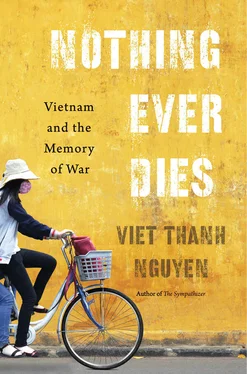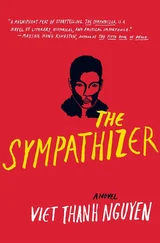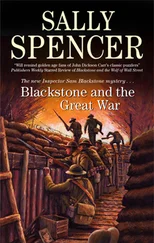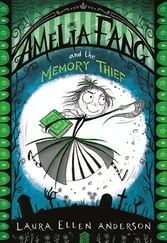PROLOGUE
1. King, “Beyond Vietnam,” 144.
2. Ibid., 156.
3. For an overview of the connections that Americans have made between the wars in Vietnam and Iraq, see Gardner and Young’s edited collection Iraq and the Lessons of Vietnam , and Dumbrell and Ryan’s edited collection Vietnam in Iraq .
4. King, 194–95.
5. Ibid., 143. For more on the controversial nature of King’s speech at the time of its delivery in 1967, and the tradition of antiwar protest among black intellectuals such as Frederick Douglass and W. E. B. DuBois, see Aptheker, Dr. Martin Luther King, Vietnam, and Civil Rights .
6. Guevara, On Vietnam and World Revolution , 15. He was not the only Latin American to have this sentiment, as Macarena Gómez-Barris shows in her interview with the Chilean political prisoner Carmen Rojas. According to Rojas, she was “part of a generation that felt, in their own bodies, the struggle of Vietnam, and that vibrated during the anti-imperialist marches” ( Where Memory Dwells , 99).
JUST MEMORY
1. The literary and academic body of work on war and memory is substantial. While much of that work will be cited throughout the book and in subsequent endnotes, I will mention here a number of other works that I found helpful: Ashplant, Dawson, and Roper, “The Politics of War Memory and Commemoration”; Winter, “From Remembering War ”; and the following essays from War and Remembrance in the Twentieth Century , edited by Winter and Sivan: Merridale, “War, Death, and Remembrance in Soviet Russia,” Winter, “Forms of Kinship and Remembrance in the Aftermath of the Great War,” Winter and Sivan, “Introduction,” Winter and Sivan, “Setting the Framework.”
2. On violence and the founding of nations, see Renan, “What Is a Nation?”
3. Shacochis, The Woman Who Lost Her Soul , Kindle edition, 196.
4. Two useful, concise overviews of the history of the war from both American and Vietnamese perspectives are Bradley’s Vietnam at War and Lawrence’s The Vietnam War . In writing this book, I also drew on longer histories by Young ( The Vietnam Wars ) and Logevall ( Embers of War ).
5. Um raises similar issues about the way the name of the war contains its meaning in her article “The ‘Vietnam War’ ”: What’s in a Name?”
6. In America’s Shadow and American Exceptionalism in the Age of Globalization , scholar William Spanos has placed the Vietnam War at the center of his critique of American empire in the twentieth century. Edward Said’s landmark Orientalism connects the European imagination of the “Near East” and “Middle East” with the American imagination of the “Far East.” For Said, the Oriental includes not just America’s enemies in the Pacific during the mid-twentieth century but its new enemies in the Middle East during the late twentieth century and beyond.
7. Dudziak, War Time: An Idea, Its History, Its Consequences , 8.
8. These percentages are based on my own calculations of Vietnamese casualties in relationship to census counts for northern and southern populations. For a more detailed exploration of casualties for Americans, Vietnamese, Laotians, and Cambodians, see Turley, The Second Indochina War , 255–58.
9. Ginzburg, A Place to Live , 58.
10. For an account of the United States’ allied troops from Korea, Thailand, Australia, the Philippines and New Zealand, see Blackburn. For a discussion of the war’s international dimension, see Bradley and Young’s Making Sense of the Vietnam Wars .
11. For an account of how spaces of memory are limited for immigrants to the United States, see Behdad, A Forgetful Nation .
12. For additional important works on collective memory, see Olick, The Politics of Regret , and Lipsitz, Time Passages .
13. Young, The Texture of Memory , xi.
14. Bercovitch, Rites of Assent , 1–67, particularly 19–22.
15. Kundera, The Book of Laughter and Forgetting , 218.
16. These ideas about the ethics of remembering one’s own and others appeared in an early form in my essay “Just Memory: War and the Ethics of Remembrance.”
17. For an illuminating exploration of the nuances of nostalgia, see Boym, The Future of Nostalgia .
18. For surveys of the idea of a memory industry and a memory “boom” that has exploded since the 1970s, see the following essays from The Collective Memory Reader , edited by Olick, Vinitzky-Seroussi, and Levy: Rosenfeld, “A Looming Crash or a Soft Landing? Forecasting the Future of the Memory ‘Industry’ ”; Nora, “From ‘Reasons for the Current Upsurge in Memory’ ”; and Olick, Vinitzky-Seroussi, and Levy, “Introduction.”
19. On the memory industry and its relationship to power, see Sturken, Tourists of History.
20. Zelizer, Remembering to Forget , 4.
21. Freud, “Remembering, Repeating, and Working-Through.”
22. For some of these critiques of identity, see Michaels, The Trouble with Diversity and Schlesinger, The Disuniting of America.
23. Charles Maier, for example, in his article “A Surfeit of Memory?” blames fragmentation and grievance — the telltale signs of identity politics, or “narrow ethnicity” (444) — for preventing an orientation toward the future and transformative politics. But perhaps it is these movements for transformative politics that have not adequately dealt with the wounds of the past, or which have not been inclusive enough, which would limit their transformative ability for those afflicted with “narrow ethnicity.”
24. Many scholars of memory have made the case for the mutually constitutive relationship of memory and forgetting. To name just two: Connerton, “Seven Types of Forgetting,” and Schacter, The Seven Sins of Memory .
25. Ricoeur, Memory, History, Forgetting , 57.
26. Nietzsche, On the Advantage and Disadvantage of History for Life , 10, italics in original.
27. Ricoeur, Memory, History, Forgetting , 68.
28. Borges, “Funes the Memorious,” in Ficciones , 107.
1. ON REMEMBERING ONE’S OWN
1. For an overview of how Vietnam has dealt with its war memories, see Tai’s edited collection The Country of Memory .
2. Augé, “From Oblivion ,” 473–74.
3. Kundera, The Book of Laughter and Forgetting , 217.
4. For more on the mourning practices for dead revolutionary soldiers, see Malarney, “The Fatherland Remembers Your Sacrifice” and Culture, Ritual and Revolution in Vietnam .
5. Didion, Blue Nights , 13.
6. Margalit, The Ethics of Memory , 8.
7. Forster, Aspects of the Novel , Kindle edition, loc. 735–850.
8. For a more detailed study of Vietnamese practices of remembering the American war, see Schwenkel’s The American War in Contemporary Vietnam .
9. For a detailed account of “Uncle Ho,” see Duiker’s Ho Chi Minh .
10. Ninh, The Sorrow of War , 232.
11. Ibid., 42.
12. Ibid., 57.
13. On trauma and its repetitive remembering, see Caruth, Unclaimed Experience .
14. Ninh, The Sorrow of War , 180. On trauma and the possibilities of a victim repeating the violence, which might explain Kien’s violent behavior, see Leys, Trauma .
15. Ninh, The Sorrow of War , 204. On the prevalence and traumatic impact of rape, see Herman, Trauma and Recovery ; on the shame of sexual stigmatization, and the haunting legacies of sexually traumatized women in the parallel case of war-torn Korea, see Cho, Haunting the Korean Diaspora ; on rape in the Vietnam War, see Weaver, Ideologies of Forgetting .
Читать дальше












